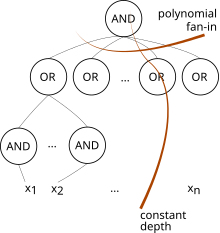AC0

AC0 is a
Example problems
Integer addition and subtraction are computable in AC0,[2] but multiplication is not (specifically, when the inputs are two integers under the usual binary[3] or base-10 representations of integers).
Since it is a circuit class, like P/poly, AC0 also contains every unary language.
Descriptive complexity
From a
Separations
In 1984 Furst, Saxe, and Sipser showed that calculating the parity of the input bits (unlike the aforementioned addition/subtraction problems above which had two inputs) cannot be decided by any AC0 circuits, even with non-uniformity.[5][1] It follows that AC0 is not equal to NC1, because a family of circuits in the latter class can compute parity.[1] More precise bounds follow from switching lemma. Using them, it has been shown that there is an oracle separation between the polynomial hierarchy and PSPACE.
References
- ^ Zbl 1193.68112.
- ^ Barrington, David Mix; Maciel, Alexis (July 18, 2000). "Lecture 2: The Complexity of Some Problems" (PDF). IAS/PCMI Summer Session 2000, Clay Mathematics Undergraduate Program: Basic Course on Computational Complexity.
- ^ Kayal, Neeraj; Hegde, Sumant (2015). "Lecture 5: Feb 4, 2015" (PDF). E0 309: Topics in Complexity Theory. Archived (PDF) from the original on 2021-10-16. Retrieved 2021-10-16.
- ^ Immerman, N. (1999). Descriptive Complexity. Springer. p. 85.
- Zbl 0534.94008.
